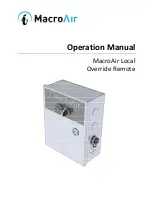
10
WARNING:
For your own safety, turn off power at fuse box or circuit breaker before trouble shooting your fan.
Trouble Shooting
TROUBLE
PROBABLE CAUSE
SUGGESTED REMEDY
1. Fan will not start.
1. Fuse or circuit breaker blown.
1. Check main and branch circuit fuses or circuit
breakers.
2. Loose power line connections to the fan,
2. Check line wire connections to fan and switch
or loose switch wire connections in the
wire connections in the switch housing.
switch housing.
WARNING:
Make sure main power is
turned OFF.
3. Reversing switch in neutral position.
3. Make sure reversing switch position is all the
way to one side.
2. Fan sounds noisy.
1. Blades not attached to fan.
1. Attach blades to fan before operating.
2. Loose screws in motor housing.
2. Check to make sure all screws in motor housing
are snug (not over-tight).
3. Screws securing fan blade flanges to
3. Check to make sure the screws which attach
motor hub are loose.
the fan flanges to the motor hub are tight.
4. Wire connectors inside switch housing
4. Check to make sure wire connectors in switch
rattling.
housing are not rattling against each other or
against the interior wall of the switch housing.
WARNING:
Make sure main power is
turned OFF.
5. Screws holding blades to flanges
5. Tighten screws securely.
are loose.
3. Fan wobbles
1. Setscrew in motor coupling is loose.
1. Tighten both setscrews securely in the motor
excessively.
coupling.
2. Setscrew in hanger ball/downrod
2. Tighten the setscrew in the hanger ball/
assembly is loose.
downrod assembly.
3. Screws securing fan blade flanges to
3. Check to be sure screws which attach the fan
motor are loose.
blade flanges to the motor are tight.
4. Fan blade flanges not seated properly.
4. Check to be sure the fan blade flanges seat
firmly and uniformly to the surface of the motor.
If flanges are seated incorrectly, loosen the
flange screws and retighten according to the
procedure in the section on "How to Put
Your Ceiling Fan Together".
5. Hanger bracket and/or ceiling outlet
5. Tighten the hanger bracket screws to the outlet
box is not securely fastened.
box, and/or secure outlet box.
6. Fan blades out of balance.
6. Interchanging an adjacent (side-by-side) blade
pair can redistribute the weight and result in
smoother operation.
!
!
!
Ceiling fan performance and energy savings rely heavily on
the proper installation and use of the ceiling fan. Here are a
few tips to ensure quality and product performance.
Choosing the Appropriate Mounting Location.
Ceiling
fans should be installed, or mounted, in the middle of the
room and at least 7 feet above the floor and 18 inches from
the walls. If ceiling height allows, install the fan 8 - 9 feet
above the floor for optimal airflow. Consult your Emerson
Retailer for optional mounting accessories.
Using the Ceiling Fan Year Round.
In the summer, use
the ceiling fan in the counter-clockwise direction. The airflow
produced by the ceiling fan creates a wind-chill effect,
making you "feel" cooler. Select a fan speed that provides a
U.L. Model No.: CF452
Energy Efficient Use of Ceiling Fans
comfortable breeze, lower speeds consume less energy. In
the winter, reverse the motor and operate the ceiling fan at
low speed in the clockwise direction. This produces a
gentle updraft, which forces warm air near the ceiling down
into the occupied space. Remember to adjust your
thermostat when using your ceiling fan - additional energy
and dollar savings could be realized with this simple step!
Turn Off When Not in the Room.
Ceiling fans cool
people, not rooms. If the room is unoccupied, turn off the
ceiling fan to save energy.






























